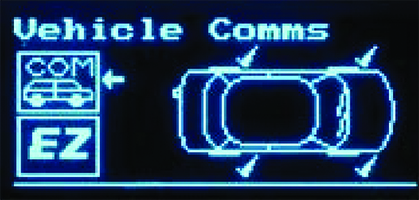In order to properly service a tire pressure monitoring system, you must first understand the functionality of the system’s wireless signal. Unfortunately, there is a lot of misinformation out there about the TPMS wireless signal, which could get in the way of your diagnostics and your ability to sell TPMS service.
PMS wireless signal” will bring up a study done by Rutgers University entitled “Wireless Tire Pressure Monitoring Systems in Cars May Compromise Privacy, Pose Security Threat” as a top result. This study from several years ago asserts that TPMS wireless signals, because of the unique codes in each wheel sensor, could lead to a driver’s location being tracked, or a hacker mimicking the sensor signal and sending false readings to trigger a car’s dashboard warning display.
While the study sounds credible, every concern has been debunked. The transmitters in TPMS sensors are low signal devices subject to FCC Part 15 and are Class C devices. The signals are unencrypted, but the signal is so minimal that it cannot be read by anyone more than 100 feet away.
Actually hacking into a TPMS via the wireless signal to illuminate the TPMS light on the dashboard would require a ridiculous amount of effort. The hacker would have to be at least within 30 feet of the vehicle for an extended period of time, and would have had to account for the hundreds of TPMS protocol variations on the road – all to illuminate a dashboard light.
Anyway, enough with the false information. We reached out to several aftermarket TPMS suppliers for some real insight into the TPMS wireless signal.
What information is contained in a TPMS signal?
Most generally, a typical wheel- mounted TPMS sensor will transmit data about tire pressure, and that’s it. Some offer real-time tire temperature readings. Newer tire-mounted models are said to be capable of gauging acceleration and, in some cases, the direction the wheel is spinning. Some systems display tire pressure by location on the instrument panel, but most do not.
In the future, advanced tire information systems will have an expanded role that will include enhanced monitoring of pressure, temperature, acceleration, run-flat mileage, load detection, tread depth and storage of tire data. All of these future developments will have far-reaching benefits. Down the line, this information will be processed and the suspension, powertrain and braking characteristics of a vehicle could be further optimized as a result.
How often is a sensor transmitting information?
This varies among manufacturers, but generally sensors have different settings while parked and while in motion. In rolling mode, sensors transmit, on average, once every 60 seconds to 180 seconds. These transmissions both aid in the relearn process and check in with the system.
While parked or in stationary mode, depending on the manufacturer, sensors may transmit periodically or when a pressure change is detected. If there is a slow leak, it will be ready to display on the dash when the car is started.
In the event of rapid air loss, most sensors go into an alert mode that ramps up the transmissions to deliver a swifter warning.
Are TPMS sensors able to report on the status of their battery life?
This depends on the TPMS sensor. There are some models that can send a signal to indicate reduced battery voltage if it goes beyond a specified limit, but not all sensors send such a signal, and this information is often inconsistent.
For instance, cold temperatures can cause a temporary voltage reduction that only corrects itself once the tires warm up. The only proven way to know how much battery life remains is to fully use the sensor to depletion.
But a report on a sensor’s battery life might not be necessary anyway because these batteries have shown to have a fairly long shelf life. Road hazards and environmental decay are a much bigger factor in sensor life than battery depletion, which underscores the need for proper service of TPMS sensors. Be sure to replace the wear items – the valve core, assembling nut, seal and dust cap – on a regular schedule.
What outside signals can interfere with TPMS signals?
Direct TPMS uses radio signal technology and is prone to interference. The majority of TPMS sensors are activated with a low frequency (LF) signal (125 KHz). This LF signal varies from vehicle to vehicle (some require more power than others) and forces the sensor to transmit. The TPMS sensors then transmit information and communicate via a UHF signal (314.9-433.92 MHz).
So, anything transmitting in this range, or anything that would block a radio signal, such as metal, could cause moments of interference. But interference isn’t too common, overall, and requires the interference source to be within close range and remain constant for a period of time.
There have been reports of metallic window film causing system problems, as well as wireless transmitters in a shop causing intermittent problems. Another instance of interference involved an electric motor that wasn’t properly grounded and prevented nearby TPMS sensors from being activated. Microwaves, CRT computer monitors, and time card readers can all potentially create interfering signals as well, but these are obviously rare.
Just be aware that if there is interference, especially inside, moving the vehicle outside (or even sometimes another foot or two if the caliper is causing the interference) is usually enough to clear things up.
During a relearn procedure, a Honda service bulletin from 2010 entitled “Keep Your Distance When Doing Sensor ID Learning” recommended a clearance of 10 feet between the TPMS sensors being relearned and any other TPMS sensors nearby.
If the TPMS sensors are too close, one or more of them will be triggered and learned instead of the one that needed it. If this happens, the low tire pressure indicator will keep flashing and won’t turn off when the vehicle is driven over 28 mph.













